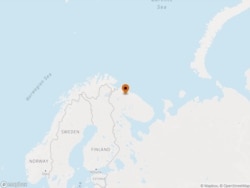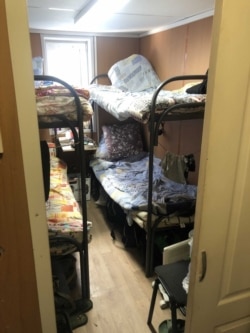MURMANSK, Russia -- Until recently, the massive Kola Yard project in the town of Belokamenka on the western shore of the Kola Bay was best known as a flagship of Russia’s effort to develop the Far North and open the Arctic region for economic exploitation.
Under development for six years now, this project by natural-gas firm Novatek will build gas platforms that can be towed out into the relatively shallow waters along Russia’s Arctic coast. The goal is to boost Novatek’s liquefied natural gas (LNG) production to some 34 million tons a year, with much of it being exported via the Northern Sea Route to customers in East Asia.
In recent weeks, however, Belokamenka -- which reported a population of just 84 people in the 2010 census -- has acquired a new renown as a major hotspot in Russia’s ongoing COVID-19 crisis. The construction site, which employs 9,000-11,000 workers from across Russia and the former Soviet Union, has officially registered more than 2,000 cases of the coronavirus. And the figures continue to rise by at least 100 each day.
As of May 11, Murmansk Oblast had officially registered 2,416 coronavirus infections, 2,045 of them in Belokamenka. The region had registered five deaths from COVID-19 -- but there is evidence that official fatality figures across Russia may be substantially lower than the real toll.
The same day, President Vladimir Putin ordered the Emergency Situations Ministry to send a second mobile hospital to Belokamenka by May 20.
Belokamenka is just one of many remote Murmansk region settlements straining to cope with the coronavirus crisis with political, economic, and social infrastructures dominated by a single employer whose priorities -- even in the best of times -- do not always coincide with those of local residents.
No Comment
Information from the project is hard to come by. Novatek declined to comment for this story.
“My husband has been given a respirator mask,” Tatyana, who did not want her last name published for fear of repercussions, told RFE/RL by telephone from the southern Russian city of Krymsk. “But far from everyone there has one. As far as I know, there has been no disinfection there and it is impossible to practice social distancing. There are no sanitizers and no gloves. They do haphazard testing. No one on my husband’s team has been tested at all.”

Tatyana said her husband’s two-month shift at the site has officially ended, but she has no idea when he will be able to return to his family. Workers at the site generally work one- or two-month shifts and then return home for one month of rest.
“My husband was supposed to be evacuated from the site,” she said. “There were 38 of them ready to go. They were packed and put on a bus, but they were turned back at the gate. They thought they’d be able to leave the next day, but they couldn’t. I’m worried that if they don’t evacuate the healthy people, then all of them will be infected. Who knows how the disease will develop?”
As a rule, workers at Kola Yard are housed in modified shipping containers, with eight workers living in a space 2.5 meters by 8 meters.
“What precautions can be taken there?” asked a worker who wished to be identified only as Nikolai.
Mobile Hospital
Patient Zero at Belokamenka is believed to have been a migrant worker from Kyrgyzstan who arrived at the site in late February and soon tested positive. It is unknown where or how he became infected.
On March 31, authorities imposed a quarantine on Belokamenka, although work on the site was not discontinued. On April 1, the Murmansk office of opposition politician Aleksei Navalny posted assertions from workers at the site that new workers coming into Kola Yard were being held in quarantine, “but are being released after 5-6 days.”
The first official reports of coronavirus infection at Kola Yard came on April 12, although no numbers or details were provided.
A video posted on April 15 appeared to show workers at the site lined up outside a kiosk without protective gear and ignoring social-distancing protocols.
The same day, Murmansk Oblast Governor Andrei Chibis reported, a first mobile hospital with 500 beds was set up on the site.
On May 1, the local coronavirus information portal reported that a female worker at the site had died after testing positive for the coronavirus. That initial report was later removed and replaced by one saying that she had tested negative.
On May 9, state media reported that a 55-year-old driver at the Belokamenka project had died of double pneumonia after testing positive for the coronavirus.
A leading contractor at the site, Velesstroi, reported on April 23 that it was evacuating some of its personnel from the construction site because of the outbreak. Media reports said the workers were briefly kept at a hotel in Murmansk before being put on charter flights to Moscow and two other big cities further south, Samara and Yekaterinburg.
Spreading Southward
Health experts fear, however, that Belokamenka is not only a hotspot for the virus but potentially also a source for spreading it across the country.
At least four of the Belokamenka workers tested positive for the coronavirus after reaching Yekaterinburg, local media reported on May 11. That news came after at least 11 Kola Yard workers tested positive in Yekaterinburg after arriving from Murmansk in late April. Nonetheless, officials in Murmansk insist that all workers are quarantined for two weeks and must test negative for the virus before being allowed to leave the construction site.
According to Novaya gazeta, a worker named Vitaly, who said he has tested positive for the coronavirus although he has no symptoms, was told on April 24 that he could continue working at Kola Yard “on a voluntary basis.” In an interview with RFE/RL, Velesstroi human-resources director Maksim Glotov said workers themselves were insisting they wanted to stay on the job.
“We have here people with positive and with negative test results living together,” Glotov said. “It doesn’t hamper their work. In this situation, it is even better than being shut up in a closed space. And the initiative came from the people themselves, who asked if it is possible not to cancel their tour. And that is people who are positive and who are negative. The main thing is that they don’t have a fever or other symptoms. Before starting work, they all have their temperatures taken.”
A worker who asked to be identified as Nikolai told RFE/RL that workers are only allowed into the site cafeteria in groups of 10. However, he said, while those small groups are eating, crowds of workers stand around outside the building waiting their turn.
During the two or three hours that meals are served, people are spending 30 or 40 minutes waiting in line, Nikolai said.
In a conversation with Putin on April 28, regional governor Chibis said “the outbreak of the virus at Belokamenka has been localized” -- suggesting that it had been contained and was under control. At the time, the settlement had 922 confirmed infections.













